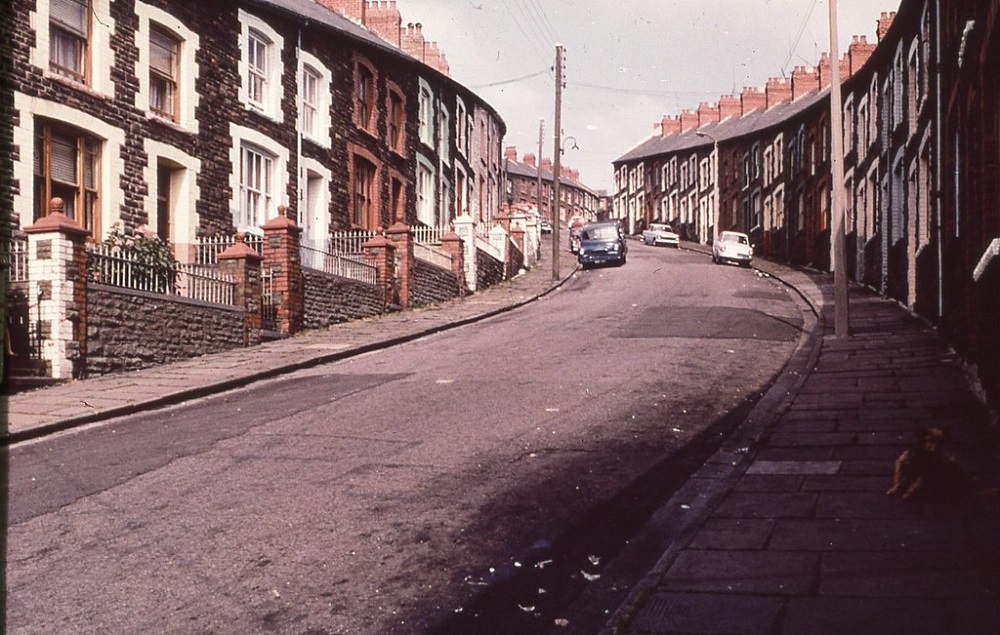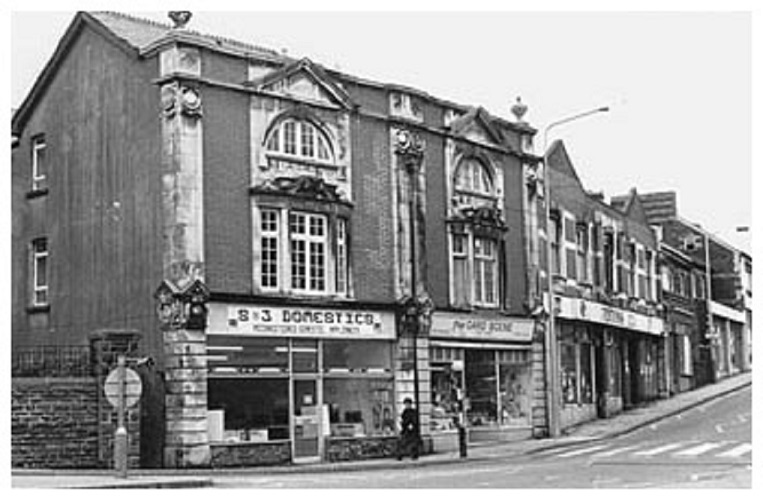Up The Rhondda! Shopping at the Kwop

Nation.Cymru is delighted to bring you another extract from ‘Up The Rhondda!’ by John Geraint, which has just been published by Y Lolfa.
John Geraint
You’ve caught me on the hop here… I’m out shopping. And all without so much as talking to a shop assistant. Here I am scanning my own groceries… in Welsh. The things you can do nowadays!
The Welsh Government wants a million Welsh-speakers by 2050. It’s official policy. I wonder if they’re counting machines like this one, as well as people.
“Diolch am siopa yn y Coe-Op,” it says – thanks for shopping where? The Coe-Op? It’s the Kwop, or the Kop, mun. If you’re speaking Welsh, talk tidy!
The Kwop. The Kop. One or the other. That’s what it is. The definite article and one syllable, not two. That’s what we call it in Penygraig, anyway. And in Penygraig, like lots of other Rhondda towns, the Kwop – or Kop – had a proud history. So let me tell you about it.
Initiate the movement
It’s Saturday 16 May 1891. Penygraig is a bustling new town, expanding rapidly in the shadow of mid-Rhondda’s coalpits, home to one of Wales’s leading rugby clubs and to a splendid brass band all of its own. And there are shops and pubs and cafés and churches and chapels.
But a new idea is about to take root here. In the Long Room of The Butcher’s Arms – a famous meeting place for miners – a gathering is underway. The express purpose is ‘to initiate the movement of starting a Co-operative Society’. Not to start a Co-operative Society, mind you, but to ‘initiate the movement of starting’ such a society.
If you’re sensing some hesitation there, it’s not surprising. A year or two earlier, a similar venture in Tonypandy had collapsed. A lot of investors had got their fingers burned. But us Penygraig people are made of stern stuff: the Penygraig Industrial Cooperative Society was duly constituted. Sums of £5, £10, even £20 were deposited as shares.
Shop premises were bought from Moses Rowlands: a mine-owner as well as a shopkeeper, a big cheese in Penygraig. I don’t know if he sold cheese, mind. But the Kwop was about to.
Because that was the whole idea: to sell groceries and other essentials – clothes and boots and shoes and ironmongery, even – and to do that at competitive prices.
But, and this was crucial point, rather than the profit on the sales falling into the hands of a single owner (someone like Moses Rowlands) who was already rich enough to finance the business privately, it was the members of the Cooperative Society themselves who were to benefit from the profits accrued. They would get a dividend.
Between them, they would own the business where they shopped, so they were perfectly entitled to share out the profits in whatever way they liked. And what they liked was sharing it amongst themselves.
The ‘Kwop Divi’ had arrived in the Rhondda.
Dividend
Local people liked this new idea. Business boomed. In its first trading quarter, ending on 31 December 1891, the balance sheet showed that the Penygraig Kwop had sold goods to the value of £1,722, 3 shillings and 6 pence. And the members got a dividend of three shillings for every pound they’d spent. Unlike those Tonypandy investors, who’d caught a cold, Penygraig had a divi that wasn’t to be sneezed at.
All the same, the Society didn’t really begin flourish until 1901, when it appointed a new manager, William Job, and a new Secretary, the splendidly named Martin Luther Thomas.
Together they worked steadily to build a stronger Society, paying high dividends, opening a bakery, and new branches in Tonyrefail and Gilfach Goch, in Coed-ely and Williamstown. In 1914, in Penygraig itself, ‘more commodious and modern’ premises were opened on Tylacelyn Road: the Society’s flagship store.

The Grocery, Drapery and Furnishing departments took up a whole block of the street-front, and the name ‘Penygraig Industrial Cooperative Society Ltd.’ was proudly inscribed above the shop windows.
Just behind the new store, on Cross Street, the imposing office headquarters oversaw a whole retail empire. But it wasn’t just about selling things. The Society played a crucial social and cultural role in the life of Penygraig.
There were educational classes, grants for schooling and lectures for members and members’ children. There were Cooperative choirs, Cooperative concerts, Cooperative eisteddfodau, Cooperative film shows.
The Kop was said to be ‘the busiest place in Penygraig’, crowded daily with people not just shopping, but making dividend withdrawals and share capital deposits, using the savings bank, collecting tickets for hospital treatment, and taking advantage of a host of other services which the Society offered.
Bitter strikes
During the bitter strikes of 1910, 1921 and 1926, the Penygraig Cooperative nailed its colours to the mast. It supported the miners and their families with credit facilities to cover the lion’s share of their weekly shopping bills, and grants which kept the wolf from the door.
Donations rolled in from other Cooperative Societies, and the Society supplied ingredients for the miners’ soup kitchens at cost price. And, in the run up to Christmas, members’ children weren’t forgotten.
When better times came around, the Penygraig Kwop prospered. When they counted it all up, in its first fifty years of trading, up until the Second World War, a staggering £8.8 million pounds was rung through the tills.
It had paid out to its members – six thousand of them by then – dividends of £780,000. At today’s values, you’re talking the kind of money only a Russian oligarch has at his disposal.
My family – on my mother’s side anyway – were stalwart members of the Penygraig Society from its earliest days. My great-grandmother, known to all as Gua, was the wife of a craftsman, the local blacksmith, and when she went shopping, even in an institution as egalitarian and fair-spirited as the Kwop, I suppose she felt that that gave her a special status.
I was always told that she would march into the store and, no matter how busy it was, how deep the queue at the counter, she would demand immediate service. No-one but William Job, the manager, was good enough to serve her.
I don’t suppose it made her very popular. I wonder what she’d make of being served by a machine.

Kwop books
My own early memories of going ‘up the Kop’ are all to do with how steep my little legs found the climb up Tylacelyn Road, and how heavy the bags of shopping were that I carried back down the road from the main store. By then, one of the senior managers in the Society was a Penygraig dignitary, Jackie Dawson Jones.
Mister Dawson Jones always wore a bow tie, I remember, though I was never served by him. I obviously didn’t have the pulling power of my great-grandmother. Thankfully, I never met him in his other official capacity either: he was a local JP.
Back home, a drawer in the sideboard was filled with Kwop books. I can see the covers now, a sickly beige, and inside the ledger of the family’s purchases, handwritten, only the duplicate pages remaining, and the blue carbon sheet tucked at the back, bearing the imprint of what we’d spent, so that our dividend could be calculated.
A lot has happened to the Kop since then, in Penygraig, elsewhere in the Rhondda and across the whole country. The story of its changing ownership is too complicated to recount here and now.
But I’m still shopping at the Kwop, and there’s still a little dividend that comes back to me with every pound I spend, even if it’s totted up electronically now when I scan my membership card at the till.
I can’t help feeling, though, that something’s been lost along the way – and not just the personal service that no machine can give you, no matter how quick and accurate it is. Not just that, but the whole cooperative idea and ideal.
Pioneers
Back on its 50th anniversary in 1941, the Penygraig Industrial Cooperative Society could boast: ‘It’s our Society. Every brick, every pound in the bank belongs to us, all six thousand members.’
By combining their resources and their spending power, the pioneers of the Cooperative Movement had invented a splendid model – but it’s now the exception rather than the rule.
Perhaps it’s time we considered why that is, why we’ve gone along with a system of retail therapy that allows a very few individuals to line their pockets with our pounds, even if we seem to be saving a few pennies along the way.
I’m a huge admirer of the way Treorchy’s high street has been revived as the home to quality independent shops owned by local people. Maybe for the inspirational people who’ve led that revival, there’s further inspiration to be found in the history of the Kop, or the Kwop… or whatever you want to call it.
‘Up The Rhondda!’ by John Geraint is published by Y Lolfa at £9.99. It’s available from any good bookshop, or directly from Y Lolfa
John Geraint is one of Wales’s most experienced documentary film-makers. His acclaimed debut in fiction, The Great Welsh Auntie Novel, was published in 2022. In this new book based on his popular John On The Rhondda podcasts, John Geraint fixes – with a film-maker’s eye – the experience of life in this vibrant, globally-renowned mining community.
Support our Nation today
For the price of a cup of coffee a month you can help us create an independent, not-for-profit, national news service for the people of Wales, by the people of Wales.








O ble mae’r ‘K’
Tafodiaeth lleol.
It comes to the unequal distribution of the total wealth and power. Most wealth and power is centralised in a small 0.1% of the population. Even in a company with many shareholders it is typical that around 87% of the share capital is owned by only a very small percentage of large shareholding. A redistribution of wealth and power across the whole population will come with the responsibilities of where the redistributed wealth is invested for the best results. It would need the whole population to be knowledgeable in finance. In return, the distribution of regular dividends will give the… Read more »
o leiaf mae rhywbeth fel Cymraeg efo’r peiriannau mae’r bobl til yn Saesneg yn unig fel arfer
Also referred to as Y Cop in post-industrial Dyffryn Nantlle in Gwynedd.